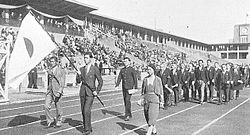This article includes a list of general references, but it lacks sufficient corresponding inline citations. Please help to improve this article by introducing more precise citations. (October 2019) (Learn how and when to remove this message)
Meiji Jingu Gaien Stadium | |
 Meiji Jingu Gaien Stadium in 1933 | |
 | |
| Full name | Meiji Jingu Gaien Stadium |
|---|---|
| Former names | Nile Kinnick Stadium |
| Location | Tokyo, Japan |
| Owner | Meiji Shrine |
| Operator | Meiji Shrine |
| Capacity | 65,000 |
| Construction | |
| Broke ground | 1 March 1922 |
| Opened | 1 January 1924 |
| Closed | 31 December 1956 |
| Demolished | 31 December 1956 |
| Tenants | |
| 1930 Far Eastern Games | |
Meiji Jingu Gaien Stadium (明治神宮外苑競技場) was a multi-use stadium in Tokyo, Japan, that could hold up to 65,000 spectators. It was the main venue for the 1930 Far Eastern Games. During the Allied occupation of Japan, from 1945 to 1952, it was renamed Nile Kinnick Stadium by the Eighth Army in honor of the winner of the 1939 Heisman Trophy.[1] The stadium was demolished to make room for Tokyo Olympic Stadium in 1956.